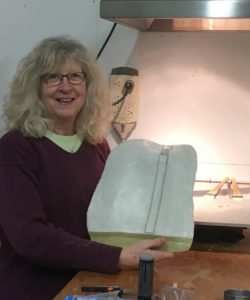
Christine Kyle
This weeks Throwback Thursday highlighted artist is Christine Kyle. Her work is currently being featured in the exhibition Creature Comforts in our Kathryn Schultz gallery until November 2nd.
What are your earliest memories of being artistic? We always made our Halloween costumes. When we were young, my mother (who dabbled in art) wouldn’t let us use coloring books because she didn’t want us to learn that we were supposed to color in the lines. My elementary school friend’s mother was an artist. She set us up with boards and oil paints. I still have the painting. It’s of ducks in the water with a house nearby.
When did art become a pursuit? I went to a Waldorf School for my last two years of high school where we were submerged in the arts. I took weaving, art and pottery. I majored in Art and Sociology as an undergraduate, got a graphic design certificate in 1985 and was a graphic designer for about 15 years. Ten years ago, I got my MFA. I’ve always pursued art.
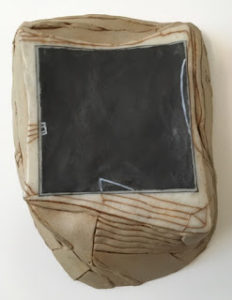
Are you self-taught or formally educated in visual art? Both.
How did you first become involved with CAA? I added CAA to my art community quite a few years ago. I would like to become more involved in CAA.
In what other ways are you involved in the local art community? I live in Cambridge and have a studio in Waltham in a garage behind a printing company and next to a woodworking shop (my husband’s). Making art is a pretty solitary endeavor. I go to open studios, art talks and museums. I prefer to go to art galleries when there isn’t an opening so I can see the art and talk with the gallery sitter. My low-residency MFA program at the Art Institute of Boston (now Lesley University School of Art and Design) revealed, to me, the world of art and artists in the Boston area and beyond. I’ve been more and less involved with different art communities at different times. I’ve shown my work in the area. I helped launch the Lexington Open Studios and was on the Lexington Arts Council when I lived in Lexington, I’m now a member of Cambridge Art Association and MassWax. I would love to be in an ongoing critique group.
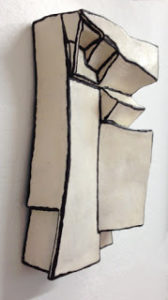
What medium do you currently work in and how did you choose this medium? Currently, I’m working predominantly with mud (ceramics) and wax (encaustic). These materials are easy to manipulate, they feel good in my hands and then can take on a life of their own. Other media (occasionally picked out of the garbage bins from the woodworking shop next door) is sometimes incorporated. I’m enjoying adding stitched fabric to my pieces these days.
What is your creative process? I look at a lot of art. Last year, I worked at Mudflat to build ceramic wall sculpture bases, not really knowing what I would do with them. I’ve been working with those bases in my studio. I look at and hold what I have, base, materials, ideas and start to make. The piece and I are on a journey and although I have an intention, I want to be open-minded to other directions. I try not to over-complicate. Almost all of my pieces go through an awkward adolescence. My interest is in solving the problem, whatever it may be. I usually take pictures of my art through the process so I can see it flat and manipulate it on the computer if I want to sketch an idea, Some pieces get reworked and some, put on a shelf for later inspiration. I always have a few pieces going at the same time.
How do you choose your subject matter? Is there a reoccurring theme that carries throughout your work? My statement:
My work focuses on developing a trust in doubt while investigating the liminal space between order and chaos. Encompassing wax, ceramic, and wood, as well as less traditional materials such as eggshells, thread, and wool in various combinations, the structure of my work is often informed by boxes, rectangles, and grids that play out in geometric and organic patterns. These formal strategies are often deployed to control, classify and confine unknown entities. We categorize things according to a taxonomy that is so culturally ingrained that we neglect in-depth analysis. For me, the process of collecting, sorting, and creating patterns is integral to each finished piece, but it is the act of choosing and the myriad possibilities that captivate me. I strive to define and capture some sense of comprehension while simultaneously challenging assumptions, stretching the boundaries of imagination and reality, and ultimately honoring the messiness of entropy.
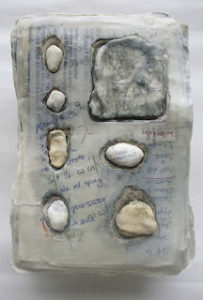
In your opinion, what’s your best/favorite piece you’ve made? This is like asking me which of my children do I like best. I’m drawn to some more than others but, a piece is not finished until I love it. “Found Lists” is special to me. It’s an intimate size and made from a pile of actual lists I used to make (now I write them on my phone) with some washer/dryer mutilated, lost information reincorporated into the pile.
What is one of your artistic goals? I’d like to have a gallery represent me.
What living artists are you inspired by? There are way too many to remember or list. A very partial list includes Rachel Whiteread, Kathleen Volp, Rachel Perry Welty, Cynthia Greig, the Gees Bend quilt-makers, Mo Kelman, Clark Derbes, Tara Donovan.
Do you own any art by other artists? Yes, I have art by Frank Campion, Joseph Santai, Amanda Barrow , and Robert Motherwell. My own art is taking over. I’d like to move my art out into the world so I can have other artists’ work influencing my day.
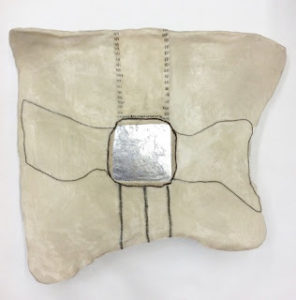
See More Christine!
Website: christinekyle.com
